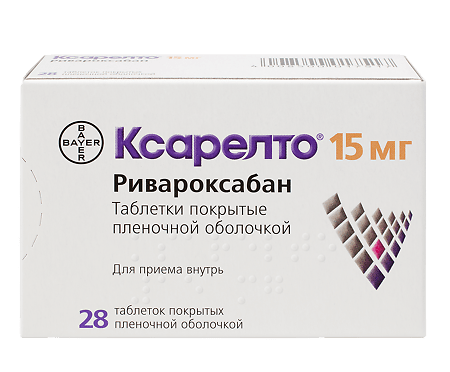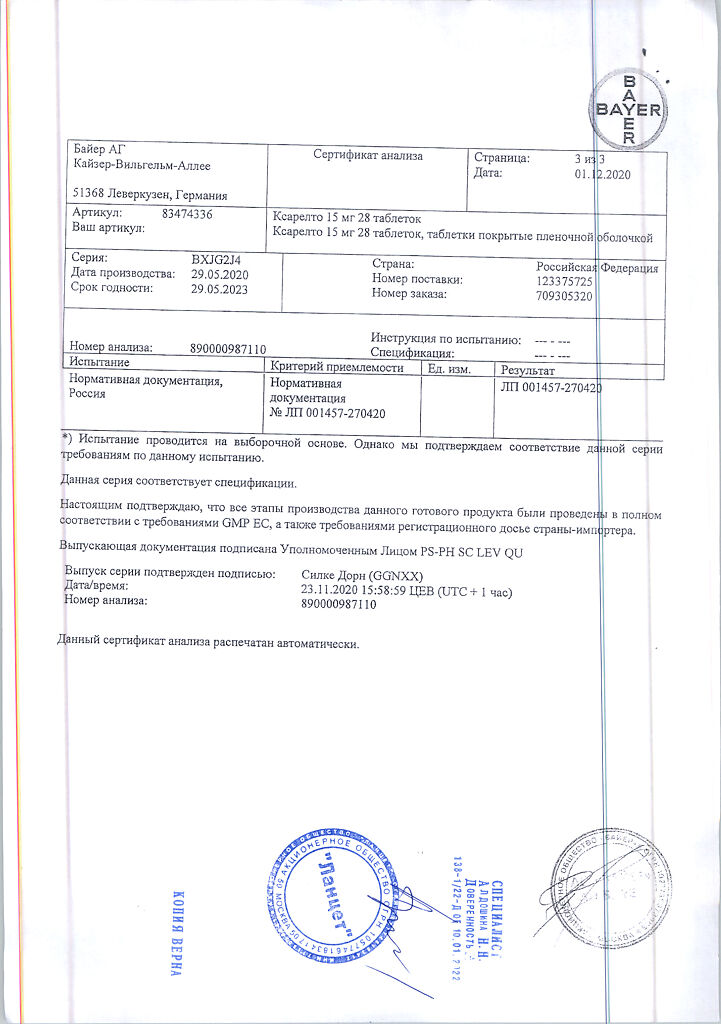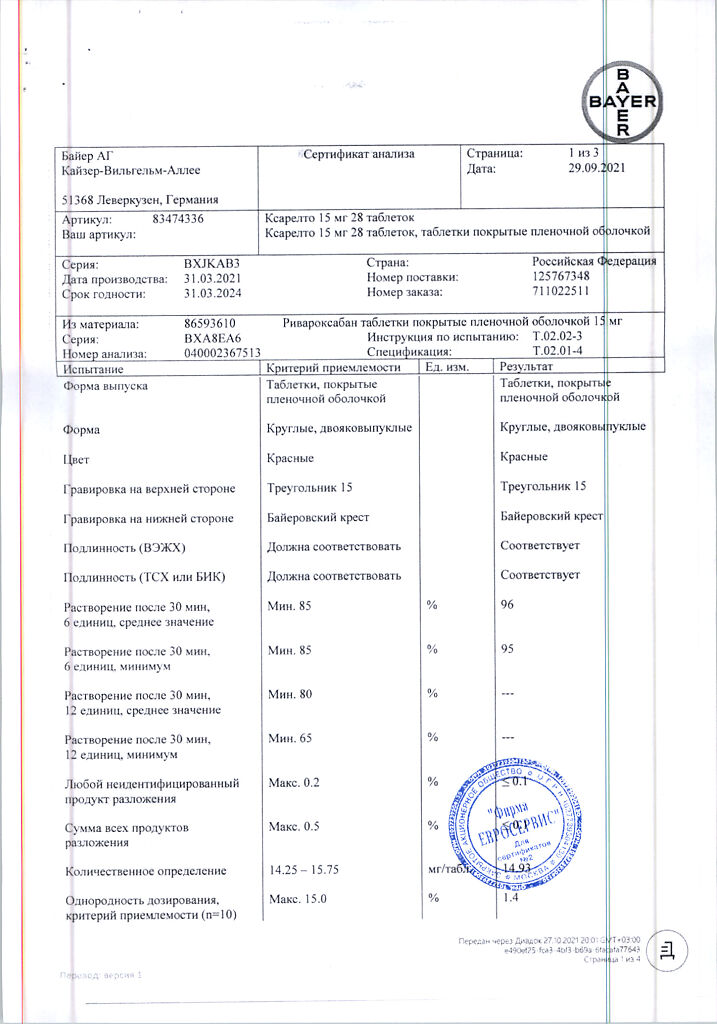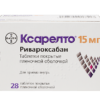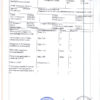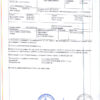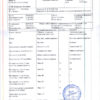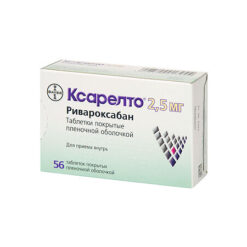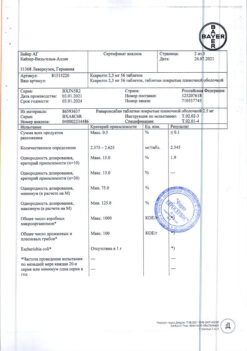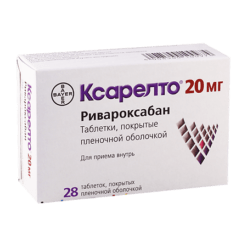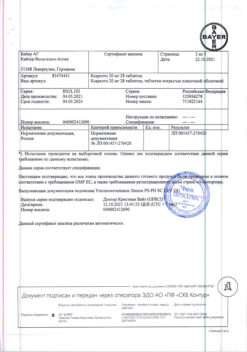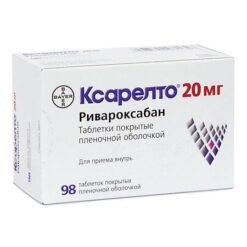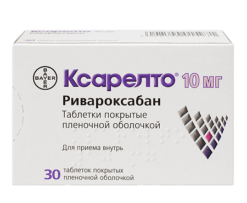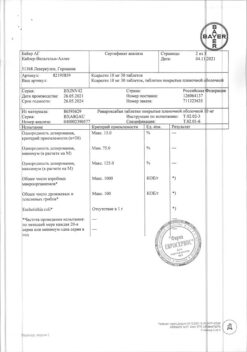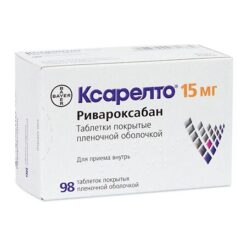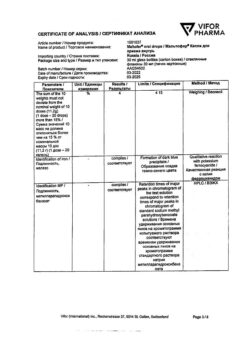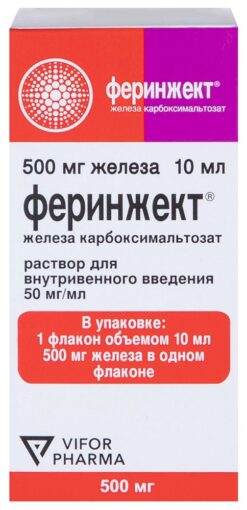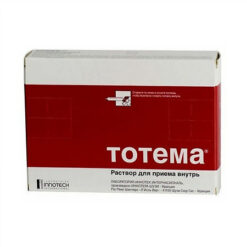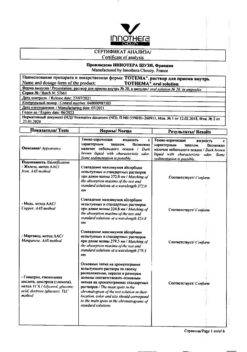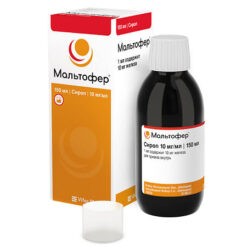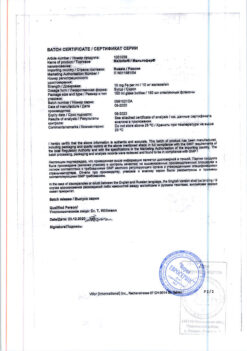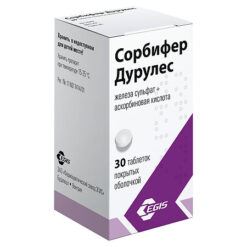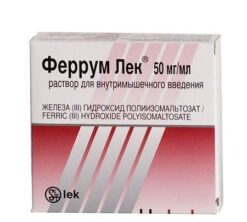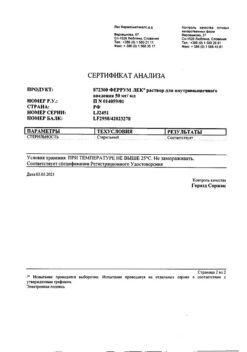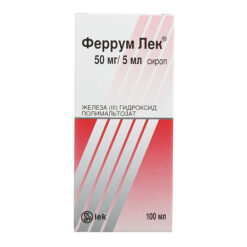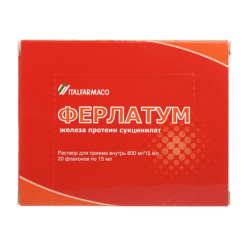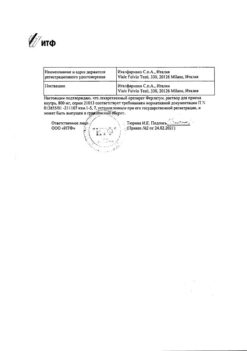No products in the cart.
Xarelto, 15 mg 28 pcs
€90.99 €75.83
Description
Xarelto is a direct-acting anticoagulant. Rivaroxaban is a highly selective direct factor Xa inhibitor with high bioavailability when taken orally. Activation of factor X with the formation of factor Xa through the internal and external clotting pathways plays a central role in the coagulation cascade.
Indications
Indications
Prevention of venous thromboembolism (VTE) in patients undergoing major orthopedic surgery on the lower extremities.
Pharmacological effect
Pharmacological effect
Xarelto is a direct-acting anticoagulant. Rivaroxaban is a highly selective direct factor Xa inhibitor with high oral bioavailability. Activation of factor X to form factor Xa through the intrinsic and extrinsic coagulation pathways plays a central role in the coagulation cascade.
Special instructions
Special instructions
The use of rivaroxaban has not been studied in clinical trials during surgery for hip fractures.
If there is an unexplained decrease in hemoglobin or blood pressure, it is necessary to look for the source of bleeding.
No prolongation of the QT interval was observed during treatment with rivaroxaban.
When performing lumbar puncture and epidural/spinal anesthesia in patients receiving platelet aggregation inhibitors to prevent thromboembolic complications, there is a risk of developing epidural or spinal hematoma, which can lead to long-term paralysis. The risk of these events is further increased by the use of indwelling catheters or concomitant use of drugs that affect hemostasis. Trauma during epidural or spinal puncture or repeat puncture may also increase the risk.
Patients should be monitored for signs or symptoms of neurological impairment (eg, numbness or weakness of the legs, bowel or bladder dysfunction). If neurological disorders are detected, urgent diagnosis and treatment are necessary. Physicians should weigh the potential benefits and risks before performing spinal surgery in patients receiving or about to receive anticoagulants to prevent thrombosis. The epidural catheter should be removed no earlier than 18 hours after the last dose of rivaroxaban. Rivaroxaban should not be administered earlier than 6 hours after removal of the epidural catheter. In case of traumatic puncture, the administration of rivaroxaban should be postponed for 24 hours.
Safety data obtained from nonclinical studies
With the exception of effects associated with enhanced pharmacological action (bleeding), analysis of preclinical data obtained in pharmacological safety studies did not reveal any specific hazard to humans.
Impact on the ability to drive vehicles and operate machinery
Studies of the effect of rivaroxaban on the ability to drive vehicles and work with potentially dangerous moving mechanisms have not been conducted.
In the postoperative period, cases of fainting and dizziness were rarely observed. Patients who experience these adverse reactions should not drive vehicles or operate moving machinery.
Active ingredient
Active ingredient
Rivaroxaban
Composition
Composition
1 tab. contains micronized rivaroxaban 15 mg.
Excipients:
microcrystalline cellulose – 37.5 mg,
croscarmellose sodium – 3 mg,
hypromellose 5cP – 3 mg,
lactose monohydrate – 25.4 mg,
magnesium stearate – 600 mcg,
sodium lauryl sulfate – 500 mcg.
Shell composition:
red iron oxide dye – 150 mcg,
hypromellose 15cP – 1.5 mg,
macrogol 3350 – 500 mcg,
titanium dioxide – 350 mcg.
Contraindications
Contraindications
clinically significant active bleeding (eg, intracranial bleeding, gastrointestinal bleeding);
liver diseases occurring with coagulopathy, which causes a clinically significant risk of bleeding;
pregnancy;
lactation period (breastfeeding period);
children and adolescents under 18 years of age (efficacy and safety for patients in this age group have not been established);
hypersensitivity to rivaroxaban or any excipients contained in the tablet.
The use of rivaroxaban has not been studied in clinical trials in patients undergoing surgery for femoral fractures. Therefore, the use of rivaroxaban is not recommended for this category of patients.
There are no clinical data on the use of rivaroxaban in patients with severe renal failure (creatinine clearance < 15 ml/min). Therefore, the use of rivaroxaban is not recommended for this category of patients.
Hereditary lactose or galactose intolerance (for example, caused by lactase deficiency or glucose-galactose malabsorption) because this medicinal product contains lactose.
Side Effects
Side Effects
The safety of rivaroxaban 10 mg was assessed in four phase III studies involving 6097 patients undergoing major lower extremity orthopedic surgery (total knee or total hip replacement) treated for up to 39 days.
Adverse reactions are classified by frequency of occurrence and organ system and should be interpreted based on the surgical situation.
Given the mechanism of action, the use of rivaroxaban may be accompanied by an increased risk of latent or overt bleeding from any organs and tissues, which can lead to posthemorrhagic anemia. Signs, symptoms, and severity (including possible death) vary depending on the location, severity, or duration of bleeding and/or anemia. The risk of bleeding may increase in patients with uncontrolled arterial hypertension and/or when used together with drugs that affect hemostasis. Hemorrhagic complications can be manifested by weakness, pallor, dizziness, headache, shortness of breath, as well as an increase in the volume of the limb or shock, unexplained by other reasons. In some cases, symptoms of myocardial ischemia, such as chest pain and angina, may develop due to anemia. Therefore, the possibility of hemorrhage should be considered when assessing a patient receiving anticoagulants.
A summary of the incidence of adverse reactions reported for Xarelto® is shown in the table below. In frequency groups, undesirable effects are presented in order of decreasing severity. Depending on the frequency of occurrence, frequent (≥ 1/100 and < 1/10), infrequent (≥ 1/1000 and < 1/100) and rare adverse reactions (≥ 1/10,000 and < 1/1000) were identified. Adverse reactions that were identified only during post-marketing observational studies or for which frequency could not be estimated are designated as “frequency unknown.”
Listed below are all adverse reactions that occurred during treatment in patients participating in phase III clinical trials.
From the hematopoietic system: uncommon – anemia (including relevant laboratory parameters), thrombocythemia (including increased platelet count).
From the cardiovascular system: infrequently – tachycardia, hypotension (including a decrease in blood pressure, hypotension during procedures), hematoma (including rare cases of hemorrhages in the muscles), bleeding from the gastrointestinal tract (including bleeding from the gums, rectum, hematemesis), hemorrhage from the genitourinary tract, nosebleeds.
From the digestive system: often – nausea, increased levels of GGT, transaminases (including ALT, AST); uncommon – constipation, diarrhea, abdominal pain (including pain in the upper abdomen, discomfort in the stomach), dyspepsia (including epigastric discomfort), dry mouth, vomiting, increased activity of lipase, amylase, increased bilirubin concentration, increased activity of LDH, alkaline phosphatase; rarely – liver dysfunction, increased concentration of conjugated bilirubin (with or without a concomitant increase in ALT activity).
From the side of the central nervous system: infrequently – dizziness, headache; rarely – short-term loss of consciousness (including syncope).
From the urinary system: rarely – renal failure (including increased creatinine concentrations, increased urea concentrations).
From the skin: infrequently – itching (including rare cases of generalized itching), rash, post-traumatic hematomas; rarely – urticaria (including rare cases of generalized urticaria), allergic dermatitis.
From the musculoskeletal system: infrequently – pain in the extremities.
From the body as a whole: often – fever, peripheral edema; infrequently – local swelling, deterioration in general health (including weakness, asthenia); rarely – poor health (including discomfort).
Other: often – hemorrhages after procedures (including postoperative anemia and bleeding from the wound); infrequently – discharge from the wound.
Other clinical studies of rivaroxaban have described isolated cases of hemorrhage in the adrenal glands and conjunctiva, as well as bleeding from gastrointestinal ulcers with a fatal outcome; in rare cases, jaundice and hypersensitivity were observed; infrequently – hemoptysis. Isolated intracranial bleeding has been described (especially in patients with arterial hypertension and/or taking concomitant medications that affect hemostasis (for example, NSAIDs, antiplatelet agents or other antithrombotic agents), which in some cases can be potentially life-threatening.
Other clinical studies have reported the occurrence of vascular pseudoaneurysm after percutaneous interventions.
Other clinical trials and post-marketing observational studies have reported known bleeding complications such as compartment syndrome. In addition, acute renal failure and renal failure have been reported as a consequence of bleeding of sufficient intensity to cause hypoperfusion.
Interaction
Interaction
Pharmacokinetic interaction
Elimination of rivaroxaban occurs primarily through hepatic metabolism mediated by the cytochrome P450 system (CYP3A4, CYP2J2), as well as through renal excretion of unchanged drug using the P-gp/Bcrp (P-glycoprotein/breast cancer resistance protein) transporter systems.
Rivaroxaban does not suppress or induce the CYP3A4 isoenzyme and other important cytochrome isoforms.
Concomitant use of rivaroxaban and strong inhibitors of CYP3A4 and P-glycoprotein may result in decreased renal and hepatic clearance and thus significantly increase systemic exposure.
The combined use of rivaroxaban and the azole antifungal agent ketoconazole (400 mg 1 time / day), which is a strong inhibitor of CYP3A4 and P-glycoprotein, led to an increase in the average steady-state AUC of rivaroxaban by 2.6 times and an increase in the average Cmax of rivaroxaban by 1.7 times, which was accompanied by a significant increase in the pharmacodynamic effect of the drug.
Co-administration of Xarelto® and the HIV protease inhibitor ritonavir (600 mg 2 times / day), which is a powerful inhibitor of CYP3A4 and P-glycoprotein, led to an increase in the average steady-state AUC of rivaroxaban by 2.5 times and an increase in the average Cmax of rivaroxaban by 1.6 times, which was accompanied by a significant increase in the pharmacodynamic effect of the drug. In this regard, Xarelto® is not recommended for use in patients receiving systemic treatment with azole antifungals or HIV protease inhibitors.
Clarithromycin (500 mg 2 times/day), a potent inhibitor of the CYP3A4 isoenzyme and a moderate inhibitor of P-glycoprotein, caused an increase in AUC values by 1.5 times and Cmax of rivaroxaban by 1.4 times. This increase is of the order of normal variability in AUC and Cmax and is considered clinically insignificant.
Erythromycin (500 mg 3 times/day), a moderate inhibitor of the CYP3A4 isoenzyme and P-glycoprotein, caused an increase in the AUC and Cmax values of rivaroxaban by 1.3 times. This increase is of the order of normal variability in AUC and Cmax and is considered clinically insignificant.
Fluconazole (400 mg 1 time / day), a moderate inhibitor of the CYP3A4 isoenzyme, caused an increase in the average AUC of rivaroxaban by 1.4 times and an increase in the average Cmax by 1.3 times. This increase is of the order of normal variability in AUC and Cmax and is considered clinically insignificant.
Concomitant use of rivaroxaban with dronedarone should be avoided due to limited clinical data on coadministration.
Co-administration of Xarelto® and rifampicin, which is a strong inducer of CYP3A4 and P-glycoprotein, led to a decrease in the mean AUC of rivaroxaban by approximately 50% and a parallel decrease in its pharmacodynamic effects.
Concomitant use of rivaroxaban with other strong CYP3A4 inducers (eg, phenytoin, carbamazepine, phenobarbital or St. John’s wort) may also result in decreased rivaroxaban plasma concentrations. The decrease in plasma concentrations of rivaroxaban was considered clinically insignificant.
Strong CYP3A4 inducers should be used with caution.
Overdose
Overdose
Rare cases of overdose have been reported when taking rivaroxaban up to 600 mg without bleeding or other adverse reactions. Due to limited absorption, a saturation effect is expected without a further increase in the mean plasma concentration of rivaroxaban at hypertherapeutic doses of 50 mg or higher.
The specific antidote for rivaroxaban is unknown. In case of overdose, activated charcoal can be used to reduce the absorption of rivaroxaban. Given its extensive binding to plasma proteins, it is expected that rivaroxaban will not be eliminated during dialysis.
Storage conditions
Storage conditions
The drug should be stored out of reach of children at a temperature not exceeding 30°C.
Shelf life
Shelf life
3 years
Manufacturer
Manufacturer
Bayer AG, Germany
Additional information
| Shelf life | 3 years |
|---|---|
| Conditions of storage | The drug should be kept out of reach of children at a temperature not exceeding 30 ° C. |
| Manufacturer | Bayer AG, Germany |
| Medication form | pills |
| Brand | Bayer AG |
Other forms…
Related products
Buy Xarelto, 15 mg 28 pcs with delivery to USA, UK, Europe and over 120 other countries.

